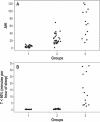The influence of intermittent hypoxemia on platelet activation in obese patients with obstructive sleep apnea
- PMID: 21509332
- PMCID: PMC3077345
The influence of intermittent hypoxemia on platelet activation in obese patients with obstructive sleep apnea
Abstract
Objectives: Literature regarding platelet function in obstructive sleep apnea (OSA) has considerable limitations. Given the central role of platelets in atherothrombosis and the known cardiovascular risk of OSA, we hypothesized that OSA severity is predictive of platelet function, independent of known comorbidities.
Design: Obese subjects, without comorbidities, underwent overnight, in-lab polysomnography. The following morning, 5 biomarkers of platelet activation were measured by whole-blood flow cytometry at baseline and in response to agonists (no stimulation, stimulation with 5 μM ADP agonist, and stimulation with 20 μM ADP agonist): platelet surface P-selectin, activated glycoprotein (GP) IIb/IIIa, and GPIb receptor expression, platelet-monocyte aggregation (PMA) and platelet-neutrophil aggregation (PNA).
Results: Of the 77 subjects, 47 were diagnosed with OSA (median apnea-hypopnea index [AHI] of 24.7 ± 28.1/h in subjects with OSA and 3.0 ± 3.9/h in subjects without OSA, p < 0.001). The groups were matched for body mass index, with a mean body mass index of 40.3 ± 9.6 kg/m(2) in subjects with OSA and 38.9 ± 6.0 kg/m(2) in subjects without OSA (p = 0.48). A comparison of time spent with an oxygen saturation of less than 90% showed that subjects who had 1 minute or more of desaturation time per hour of sleep had lower GPIb fluorescence in circulating platelets, as compared with those subjects who had less than 1 minute of desaturation time per hour of sleep; similar findings were observed following 5 μM and 20 μM of ADP stimulation, as compared with control vehicle, suggesting higher levels of circulating platelet activity. In multivariate analyses, only nocturnal hypoxemia and female sex predicted agonist response. Platelet surface P-selectin, platelet surface-activated GPIIb/IIIa, PMA, and PNA were not significantly correlated with markers of OSA.
Conclusions: In obese patients with OSA, platelet activation is associated with greater levels of oxygen desaturation, compared with matched control subjects. Metrics other than AHI (e.g., hypoxemia) may determine OSA-related thrombotic risk.
Keywords: GPIb; Platelet activation; hypoxemia; lung; obesity; sleep apnea.
Figures




Comment in
-
Platelet activity and cardiovascular risk in obesity and obstructive sleep apnea: compelling need for interdisciplinary research?J Clin Sleep Med. 2011 Apr 15;7(2):179-80. J Clin Sleep Med. 2011. PMID: 21509333 Free PMC article. No abstract available.
Similar articles
-
Increased platelet activation in sleep apnea subjects with intermittent hypoxemia.Sleep Breath. 2020 Dec;24(4):1537-1547. doi: 10.1007/s11325-020-02021-4. Epub 2020 Feb 8. Sleep Breath. 2020. PMID: 32036486 Free PMC article. Clinical Trial.
-
Postoperative hypoxemia in morbidly obese patients with and without obstructive sleep apnea undergoing laparoscopic bariatric surgery.Anesth Analg. 2008 Jul;107(1):138-43. doi: 10.1213/ane.0b013e318174df8b. Anesth Analg. 2008. PMID: 18635479
-
Obesity hypoventilation syndrome: hypoxemia during continuous positive airway pressure.Chest. 2007 Jun;131(6):1678-84. doi: 10.1378/chest.06-2447. Chest. 2007. PMID: 17565018
-
Association of obstructive sleep apnea and nocturnal hypoxemia with all-cancer incidence and mortality: a systematic review and meta-analysis.J Clin Sleep Med. 2022 May 1;18(5):1427-1440. doi: 10.5664/jcsm.9772. J Clin Sleep Med. 2022. PMID: 34755597 Free PMC article.
-
The Value of Oxygen Desaturation Index for Diagnosing Obstructive Sleep Apnea: A Systematic Review.Laryngoscope. 2021 Feb;131(2):440-447. doi: 10.1002/lary.28663. Epub 2020 Apr 25. Laryngoscope. 2021. PMID: 32333683
Cited by
-
Biomarkers of sleep apnea.Chest. 2012 Jul;142(1):239-245. doi: 10.1378/chest.11-2322. Chest. 2012. PMID: 22796846 Free PMC article. Review.
-
Hypoxia and inflammation indicate significant differences in the severity of obstructive sleep apnea within similar apnea-hypopnea index groups.Sleep Breath. 2017 Sep;21(3):703-711. doi: 10.1007/s11325-017-1486-5. Epub 2017 Mar 7. Sleep Breath. 2017. PMID: 28271327
-
The effect of duration of nasal obstruction on mean platelet volume in patients with marked nasal septal deviation.Eur Arch Otorhinolaryngol. 2016 Feb;273(2):401-5. doi: 10.1007/s00405-015-3580-2. Epub 2015 Mar 4. Eur Arch Otorhinolaryngol. 2016. PMID: 25731643
-
Cardiovascular Outcomes Post Percutaneous Coronary Intervention in Patients with Obstructive Sleep Apnea and Type 2 Diabetes Mellitus: A Systematic Review and Meta-Analysis.Diabetes Ther. 2020 Aug;11(8):1795-1806. doi: 10.1007/s13300-020-00870-6. Epub 2020 Jun 26. Diabetes Ther. 2020. PMID: 32591980 Free PMC article.
-
Metrics of sleep apnea severity: beyond the apnea-hypopnea index.Sleep. 2021 Jul 9;44(7):zsab030. doi: 10.1093/sleep/zsab030. Sleep. 2021. PMID: 33693939 Free PMC article. Review.
References
-
- Young T, Palta M, Dempsey J, Skatrud J, Weber S, Badr S. The occurrence of sleep-disordered breathing among middle-aged adults. N Engl J Med. 1993;328:1230–5. - PubMed
-
- Olson LJ, Olson EJ, Somers VK. Obstructive sleep apnea and platelet activation: another potential link between sleep-disordered breathing and cardiovascular disease. Chest. 2004;126:339–41. - PubMed
-
- Davi G, Patrono C. Platelet activation and atherothrombosis. N Engl J Med. 2007;357:2482–94. - PubMed
-
- Bokinsky G, Miller M, Ault K, Husband P, Mitchell J. Spontaneous platelet activation and aggregation during obstructive sleep apnea and its response to therapy with nasal continuous positive airway pressure. A preliminary investigation. Chest. 1995;108:625–30. - PubMed
-
- Linden MD, Furman MI, Frelinger AL, 3rd, et al. Indices of platelet activation and the stability of coronary artery disease. J Thromb Haemost. 2007;5:761–5. - PubMed
Publication types
MeSH terms
Substances
Grants and funding
LinkOut - more resources
Full Text Sources
Medical
Miscellaneous
